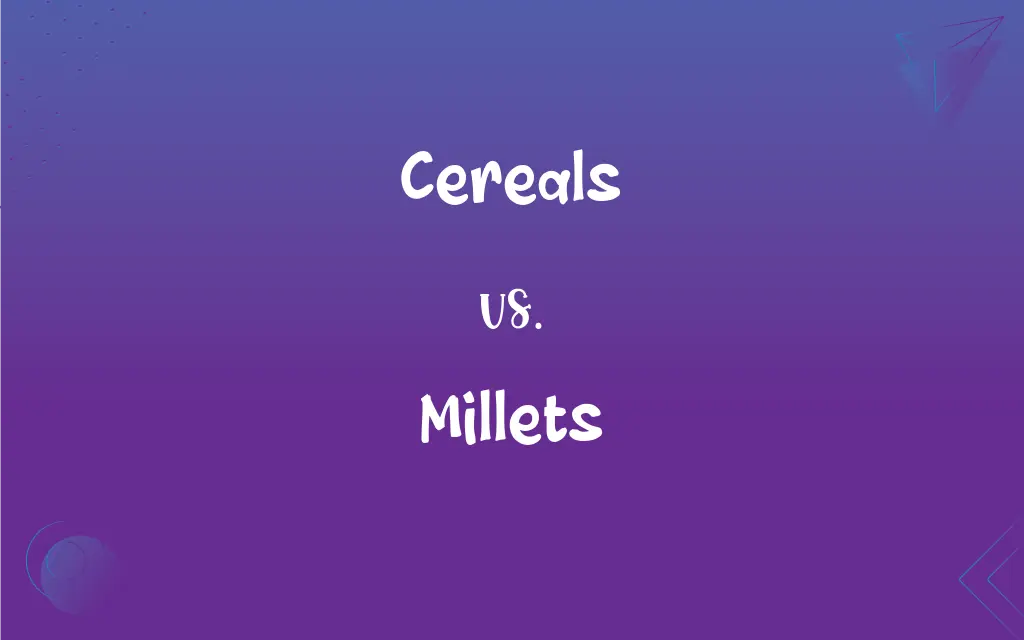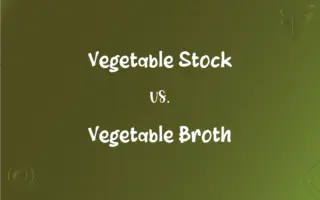Cereals vs. Millets: What's the Difference?
Edited by Janet White || By Harlon Moss || Updated on June 10, 2024
Cereals are grasses cultivated for edible grains (e.g., wheat, rice), while millets are small-seeded grasses, which are hardy and grow well in dry zones.

Key Differences
Cereals refer to grasses that are cultivated for the edible components of their grain, encompassing a wide range of agricultural plants like wheat, rice, and maize. Millets, on the other hand, consist of a group of highly variable small-seeded grasses, widely grown around the world as cereal crops or grains for both human food and fodder.
Cereals like wheat and rice are typically more dominant in global diets, while millets, like pearl millet and finger millet, often thrive in harsher environments where other crops cannot survive.
Both cereals and millets have been fundamental to human diets for thousands of years, but cereals generally have taken a more central role in most culinary traditions.
In contrast, millets often serve as staple foods primarily in semi-arid and arid regions, prized for their resilience and ability to grow in less-than-ideal soil conditions.
Comparison Chart
Definition
Grasses cultivated for edible grains
Small-seeded grasses, hardy in dry zones
ADVERTISEMENT
Example
Wheat, rice, maize
Pearl millet, finger millet
Global Prevalence
More widely consumed globally
Consumed largely in arid regions
Agricultural Demands
Often require more favorable conditions
Can grow in harsh, dry conditions
Nutritional Profile
Generally lower in micronutrients
Often higher in minerals and vitamins
Cereals and Millets Definitions
Cereals
Cereals are grasses that produce an edible grain.
Rice and wheat are two of the most commonly consumed cereals worldwide.
ADVERTISEMENT
Millets
Millets can grow in drought-prone areas.
Farmers in arid regions often rely on millets for a consistent harvest.
Cereals
Cereals can refer to breakfast foods made from processed grains.
My favorite cereals often contain a mix of oats, honey, and nuts.
Millets
Millets serve as both human food and animal fodder.
The millets that failed to reach market standards were used as animal feed.
Cereals
Cereals can also relate to the grains themselves.
These cereals are ground into flour to make bread and pastries.
Millets
Millets often possess a high nutritional value.
The iron content of certain millets is lauded by nutritionists.
Cereals
Cereals include major food staples in many cuisines.
Cereals like barley and rice are crucial for culinary traditions worldwide.
Millets
Millets are celebrated for their hardiness and adaptability.
Unlike other grains, millets can survive in nutrient-poor soils.
Cereals
Cereals are plants cultivated to extract their grains for food and fodder.
The farmer decided to plant two varieties of cereals this season.
Millets
Millets are a group of small-seeded grasses, used as grain.
Finger millet is popular in various traditional dishes in India.
Cereals
A grass such as wheat, oats, or corn, the starchy grains of which are used as food.
Millets
Any of various annual grasses with small grains that are harvested for food, livestock feed, and birdseed, especially proso millet.
Cereals
The grain of such a grass.
Millets
The grains of any of these plants.
Cereals
Any of several other plants or their edible seeds or fruit, such as buckwheat or certain species of amaranth.
Millets
Plural of millet
FAQs
What are millets?
Millets are small-seeded grasses, known for growing well in dry areas, and are used as food and fodder.
Which is more widely consumed, cereals or millets?
Cereals, like rice and wheat, are more widely consumed globally compared to millets.
Are oats considered cereals?
Yes, oats are a type of cereal grain.
Are millets used in traditional cuisines?
Yes, millets are a staple in numerous traditional cuisines, particularly in Asia and Africa.
How do the nutritional profiles of cereals and millets compare?
While both provide essential nutrients, millets often have higher levels of certain minerals and vitamins compared to common cereals.
Why are millets considered good for dry regions?
Millets are drought-resistant and can thrive in poor soil conditions, making them suitable for arid regions.
Why are millets hailed as nutritious?
Millets are often rich in fiber, vitamins, and minerals, especially when compared to more common cereals.
Do millets have different varieties?
Yes, millets come in various types, like finger millet and pearl millet, each with its unique properties.
Are all cereals and millets suitable for human consumption?
Most cereals and millets are edible for humans, but it's vital to note the specific properties of each type, as some might be more suitable for animal feed.
Are millets gluten-free?
Yes, millets are naturally gluten-free grains.
Can cereals be consumed raw?
Generally, cereals are cooked or processed before consumption, as raw grains can be difficult to digest.
What is the role of cereals in the economy?
Cereals, like wheat and rice, play a pivotal role in global economies, being fundamental to diets and agricultural sectors.
Are cereals and millets used in animal feed?
Yes, both cereals and millets can be used as fodder for animals.
Is rice a type of millet?
No, rice is a type of cereal, not a millet.
What are the health benefits of cereals?
Cereals can offer various nutrients like carbohydrates, fibers, and certain vitamins, vital for health.
Why are millets considered sustainable crops?
Millets require less water and can grow in harsh conditions, making them environmentally sustainable.
Can millets be used as a substitute for common cereals?
Yes, millets can often be used as a nutritious substitute in various dishes typically made with cereals.
How are cereals processed?
Cereals undergo various processes, such as milling, grinding, or puffing, to produce food products.
What are cereals?
Cereals are grasses cultivated for their edible grains, like wheat and rice.
What dishes are commonly made from cereals?
Cereals are used in a plethora of dishes, like bread, porridge, and noodles, depending on the type and local cuisine.
About Author
Written by
Harlon MossHarlon is a seasoned quality moderator and accomplished content writer for Difference Wiki. An alumnus of the prestigious University of California, he earned his degree in Computer Science. Leveraging his academic background, Harlon brings a meticulous and informed perspective to his work, ensuring content accuracy and excellence.
Edited by
Janet WhiteJanet White has been an esteemed writer and blogger for Difference Wiki. Holding a Master's degree in Science and Medical Journalism from the prestigious Boston University, she has consistently demonstrated her expertise and passion for her field. When she's not immersed in her work, Janet relishes her time exercising, delving into a good book, and cherishing moments with friends and family.































































